December itinerary in Japan Day 4 (Akita Day 4 Meal edition)
(Tuesday, December 14th)
Table of contents
2. Inaniwa Udon Mugendo Akita Ekimae Store
4. Akita local fish, large kamado rice Isabaya.
1. Kanbun Gonendo Akita store
The meal on the 4th day (final day) of the Aomori / Akita trip was from “Inaniwa udon”. Inaniwa udon is one of the “three major udon noodles in Japan” along with “Sanuki udon” from Kagawa and “Mizusawa udon” from Gunma. In addition, instead of Gunma’s “Mizusawa Udon”, Nagasaki Prefecture’s “Goto Udon” is sometimes referred to as “three major udon noodles in Japan”.
“Kanbun Gonendo” is a udon shop that offers raw noodles of “Inaniwa udon”, which is one of the few udon shop in Akita prefecture. It has also been selected as one of the 100 Tabelog restaurants.
Of course I knew “Inaniwa udon” and had eaten it. “Inaniwa udon” with a smooth texture is my favorite. However, I didn’t know that “Inaniwa udon” is almost exclusively dried noodles. The reason why it is almost exclusively dried noodles is that it is difficult to spread because it has been eaten as a preserved food from the beginning and the expiration date is very short. In addition, it is very difficult to produce raw noodles, and even at “Kanbun Gonendo”, only two craftsmen are involved in the production of raw noodles.
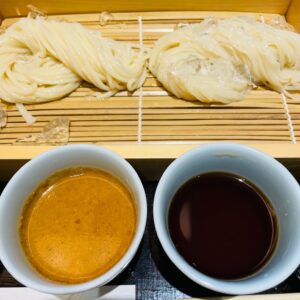
“Inaniwa udon” is said to have started when Sato Ichibei, who lived in Ozawa in the Inaniwa district in the early Edo period, manufactured dried udon noodles. It is said that Inaniwa (Sato) Yoshizaemon inherited the technique and established the technique of “Inaniwa udon” in 1665 (Kanbun 5th year). In 1752, “Inaniwa Udon” became a purveyance to Mr. Satake, the lord of the Kubota Domain (Akita Domain), and the technique became a special technique of Isshi Soden(handed down from the father to only one of his sons).
However, in 1860, the manufacturing method of Isshi Soden was specially taught to Sato Yosuke, the second generation, in order to prevent the manufacturing method from being interrupted. Sato Yosuke, the 7th generation, disclosed the manufacturing method of “Inaniwa udon” in 1972, and finally “Inaniwa udon” shifted from the family business to the industry, and the production volume increased. “Sato Yosuke Shoten” still manufactures “Inaniwa udon”.
I ordered a set (Yen 1,100) of eating and comparing raw noodles and dried noodles at Kanbun Gonendo. The dried noodles are also very delicious, but the elasticity of the raw noodles is wonderful, and the deliciousness of the raw noodles slightly surpasses that of the dried noodles. Next time, I would like to revisit Akita just to eat the raw noodles of “Inaniwa udon”.
In addition to “Inaniwa Udon”, Kanbun Gonendo offered many meals and sake, mainly Akita’s local cuisine. I thought it was a restaurant where I wanted to stay more slowly for dinner.
2. Inaniwa Udon Mugendo Akita Ekimae Store
I learned from the tourist information center of Akita Station that the history of “Inaniwa udon” I mentioned above and the fact that raw noodles are rarely offered are rare.
I didn’t know about them, so I decided to go to “Inaniwa Udon Mugendo Akita Ekimae Store” near “Kanbun Gonendo” and wanted to compare the raw noodles of “Inaniwa Udon”. However, there was only dried noodles at “Inaniwa Udon Mugendo Akita Ekimae Store”, so I had no choice but to eat dried noodles Zaru Udon (Yen 740). “Inaniwa udon” from “Mugendo” was also very delicious. “Mugendo” also has a variety of meals other than “Inaniwa udon”, and I thought it could be used as an izakaya.
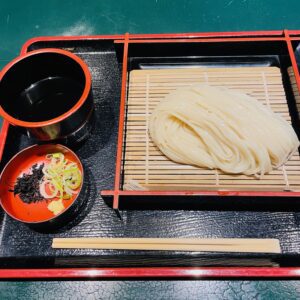
When I asked at the tourist information center of Akita Station, the raw noodles of “Kanbun Gonendo” are also offered at “Station Soba Shirakami-an”. This is due to a request from “Shirakami-an” to provide raw noodles at Akita Station.
According to the tourist information center of Akita Station, we can eat raw noodles of “Inaniwa udon” in Akita city only two places at “Kanbun Gonendo” and “Shirakami-an” using raw noodles of “Kanbun Gonendo”.
The Ministry of Agriculture, Forestry and Fisheries has selected “Inaniwa Udon” as one of the “100 Best Local Cuisine“.
There was a huge Akita dog balloon in front of the tourist information center at Akita Station. In addition, there was a Kanto on the mailbox at Akita Station. We can see that Akita City is also focusing on tourism.
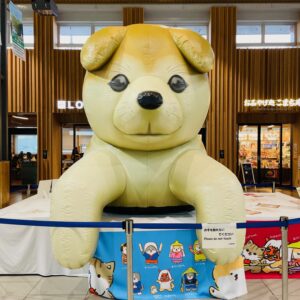
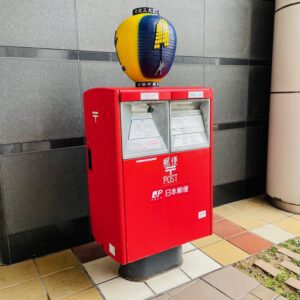
3. TO-MART
After sightseeing in Akita city, I drank craft beer produced in Akita city at “TO-MART”. I drank Belgian pale ale, Indian pale ale, farmhouse ale and American pale ale. I wanted to taste all four types that were in the store, so I drank them all in a small glass. All were very delicious beers.
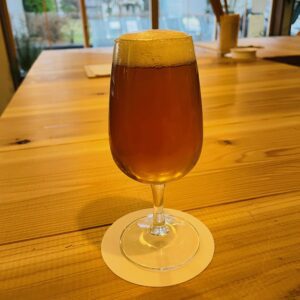
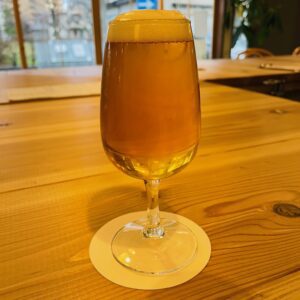
“TO-MART” is a beer bar where the owner’s wife is an architect and is next to his wife’s construction office. The interior of “TO-MART” designed by the owner’s wife was open and tasteful, and it was very comfortable. It’s nice to see more small craft beer bars like “TO-MART”.
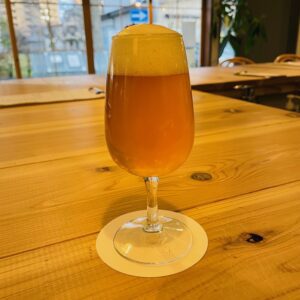
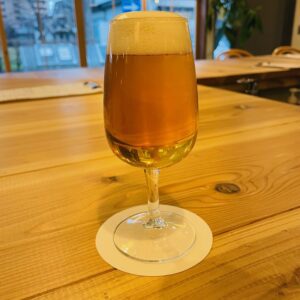
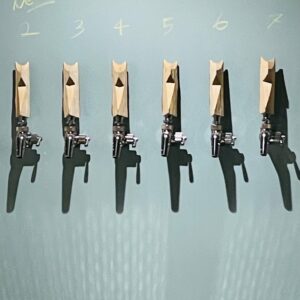
4. Akita local fish, large kamado rice Isabaya.
I had dinner at “Akita Local Fish / Okamado Rice Isabaya.” in Topico of the Akita Station Building. The bus to Akita Airport leaves from Akita Station, so I thought I’d enjoy dinner until the last minute.
At “Akita Local Fish / Large Kamado Rice Isabaya.”, I ordered an all-you-can-drink 60 minutes (Yen 980). After that, I ordered 3 kinds of sashimi, Dadami sashimi, Iburi-gakko cream cheese, Namero, fried tofu with Junsai (water shield) , fried Akita Hinai chicken kawa (skin), and Rinsendo Yokote-yakisoba.
The three types of sashimi were red sea bream, Spanish mackerel, and yellowtail. All three types were surprisingly delicious, and it was a nice start to the dinner.
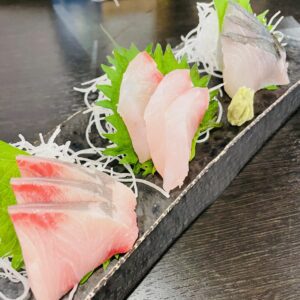
“Dadami” sashimi was the best of the day. “Dadami” is the soft roe of Pacific cod. “Dadami” sashimi is often referred to as Shirako (soft roe) ponzu nationwide. Shirako is called as “Dadami” is Akita prefecture, Yamagata prefecture, Toyama prefecture, Fukui prefecture, etc. In Hokkaido and Aomori, Shirako is called “Tachi”.
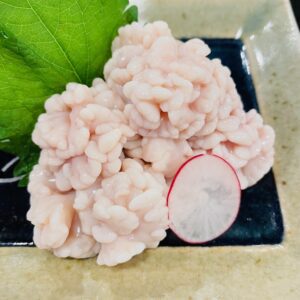
Iburi-gakko cream cheese is a typical Akita local dish. As I always think, the person who invented the combination of “Iburi-gakko” and cream cheese would be a genius. I really think that “Iburi-gakko” and cream cheese go well together. In Akita prefecture, pickles are called “gakko”.
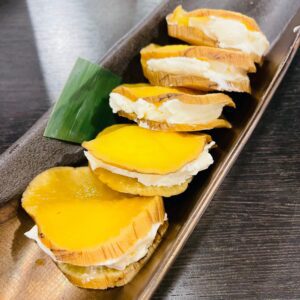
Namero, fried tofu with water shield, and fried Akita Hinai chicken kawa (skin) were more delicious than average. However, I thought that cold water shields are better than warm water shields.
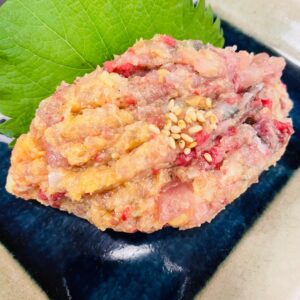
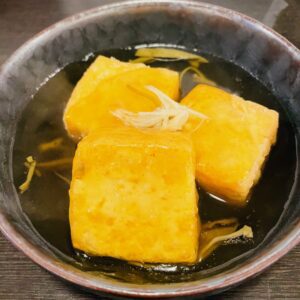
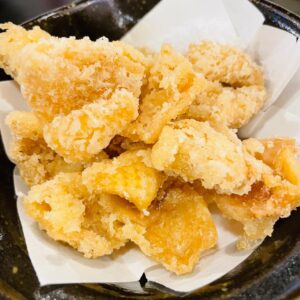
The last item I ordered, “Rinsendo Yokote Yakisoba,” is a local dish of Akita prefecture. The Ministry of Agriculture, Forestry and Fisheries has selected “Yokote Yakisoba” as a “Local dishes loved by the nation“. I was reluctant to eat Yokote’s local cuisine in Akita City, but it was delicious enough when I asked for it just in case. Someday I would like to eat authentic “Yokote Yakisoba” in Yokote City.
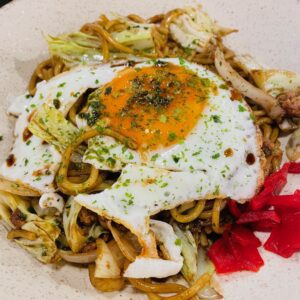
A large amount of Japanese sandfish in styrofoam box was placed outside the store of “Isabaya.” It was a beautiful Japanese sandfish. Also, I would like to come back to Akita in December to eat Japanese sandfish.
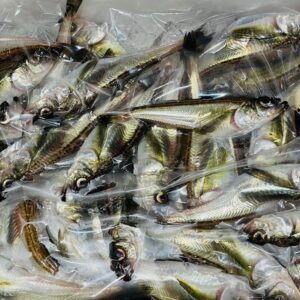
5. Akita sour
I drank “Akita Sour” limited to Akita prefecture by plane from Akita Airport to Haneda. Namahage was also printed on “Akita Sour”. It was a little too sweet sour for me.

The plane I boarded are as follows.
Depart Akita Airport at 20:00, ANA410, arrive at Haneda Airport at 21:10
The trip to Aomori and Akita for 3 nights and 4 days is over. It snowed for the last two days, but it can’t be helped during my trip to Tohoku in December. However, it was good to be able to travel the entire schedule as planned even in the snow. Especially in Hirosaki, it was a fulfilling trip with many historical buildings. Of course, the delicious seafood and local dishes that were the purpose of the trip were more delicious than I expected, and it was a very satisfying trip.
Note: The departure / arrival times, fares, admission fees, meal fees, etc. of transportation listed in the text are as of the time of writing the BLOG. Please check for yourself when you go on a trip as it may change in the future.